In the suburbs and cottage settlements, central sewage systems are extremely rare. Not to mention the dacha cooperatives and villages. But this does not mean that their residents are deprived of basic amenities - simply recycling of waste is different. There are several types of accumulation and treatment facilities. One of the most common systems of local cleaning - sewage of concrete rings.
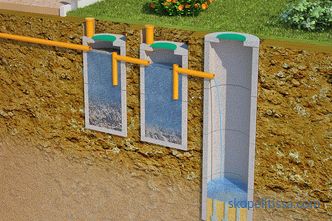
Features and advantages of concrete rings
The choice of materials for the construction of tanks, the main elements of the autonomous sewage system is large: brick, metal, plastic, solid reinforced concrete, concrete rings.
A common ceramic brick is used for this purpose if it remains in excess after construction. Its porous structure, hygroscopicity (water absorption not less than 8%) and the presence of a large number of masonry joints require complex internal and external waterproofing of the tank with coating and roll materials to prevent seepage of groundwater inwards and wastewaters to the outside.
Metal containers can be used with a reservation - only in anaerobic septic tanks, when intake of oxygen inside is limited by design and principle of action. In aerobic septic tanks in a humid, aggressive environment with forced air injection, walls, and especially welds, will quickly rust.
Plastic containers have almost no flaws. But there are restrictions on the application - they are "light", and even being filled with drains, they will remain easier than denser soil. When exposed to ground heaving forces, they can literally be squeezed out onto the surface if they are not fixed to a reinforced concrete slab installed as a base.
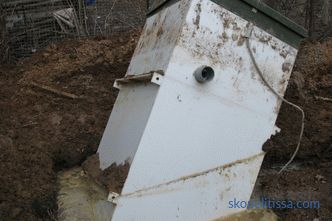
It is also desirable to strengthen the walls of the pit and to provide the protective structure of the container so that it takes loads from above.
The pouring of monolithic reinforced concrete into the formwork and its maturation takes a long time, significantly increasing the time from the start of construction to the commissioning of sewage into operation. strength, construction costs are small. And the fact that the main components of the sewage treatment facilities of the central sewage system are made of precast concrete testifies to the reliability and durability of this material.
Sewage schemes from concrete rings
Sewage from concrete rings is made according to different schemes. The specific type depends on the seasonality of living, intensity of operation, financial possibilities for the purchase of additional equipment and payment of operating costs.
The following options can be distinguished:
-
Accumulative septic tank. Behind this name is a common cesspit with a waterproof bottom and walls. Tightness - a mandatory requirement, the failure of which the administrative code of the Russian Federation is regarded as damage to the land. When drains fill the tank, a sewage truck is called.
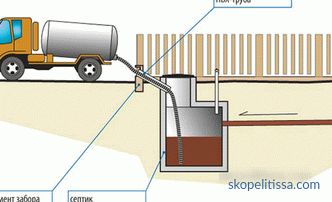
are collected The smaller the capacity and the higher the intensity of operation the points connected to the sewer, the more often it is necessary to call the machine. Often this is exactly how suburban sewers are made of concrete rings.
Note! The term "septic tank" is not used correctly in this case, since by definition it is a sewage treatment plant with sewage flowing from chamber to chamber.
-
Anaerobic septic tank. Two-, rarely single-chamber, septic tanks, in sealed containers of which wastewater is treated with anaerobic bacteria (without oxygen). The number of chambers and their volume is chosen so that at the exit of the septic tank the drains are 65-75% clean. Post-treatment takes place in filtration wells (“no bottom”), trenches or fields with aerobic bacteria (it is called “biological cleaning”). Only then can the sewage be discharged into the ground. The scheme is very popular among owners of country houses and villas because of the simplicity of the device and non-volatility. The disadvantage of the scheme is that it is necessary to periodically change the sand and crushed stone in the filtering structures, while they have to be opened and the waste material must be disposed of (although this is not often done).
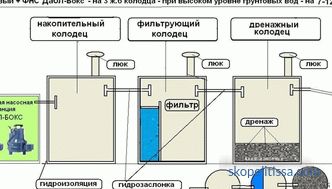
On our site you can find contacts of construction companies who offer the service of designing and installing sewage and water supply. Directly to communicate with representatives, you can visit the exhibition of houses "Low-rise Country".
-
Aerobic septic tanks and biological cleaning stations.There is also a phase of primary accumulation and partial processing of feces using anaerobic bacteria. The principle of action consists in clarification of sewage in the absence of oxygen, and tertiary treatment in the last chamber by aerobic bacteria under conditions of forced air injection. The purity of wastewater at the exit is considered to be 95-98%, and they can be dumped into the ground or used for irrigation. The disadvantage is that aerobic bacteria die if the air supply compressor does not work. And this happens when the network is bad due to power outages.
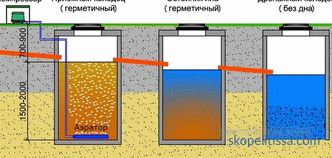
How does the sewage system
Septic tanks work the same way.
At the first stage, the preliminary separation of the wastewaters and their partial clarification occurs when exposed to anaerobic bacteria. At the second stage, tertiary treatment takes place with the help of aerobic bacteria, and in order to reduce the load on them, the first stage is often “broken” into two phases. In our case, for this we use two containers of concrete rings.
It might be interesting! In the article on the following link read about sewer pipes for outdoor sewage.
1. The first capacity
The first capacity serves as accumulative. A sewage pipe fits to it from the house, which collects drains from bathrooms, bathrooms and kitchens. When the system is started up, during the accumulation process, the wastewaters “ferment” and the formed gases displace air from the septic tank, which stimulates the rapid reproduction of anaerobic bacteria. As a result of their activities, as well as under the influence of gravitational forces, the primary sewage separation occurs:
-
heavy fractions sink to the bottom of the chamber;
-
light fractions float in the form of a film and undissolved residues;
-
the excess gases are discharged through a vertical tap of the tank or through a sewer pipe of the house sewer, and can also be forced out through a horizontal tap into the adjacent chamber;
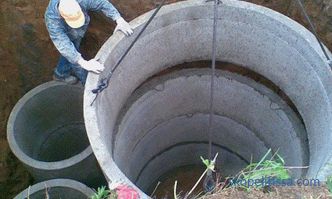
-
in the center accumulates liquid clarified fra tion waste that falls through the overflow into the next tank.
Note! A tee made of plastic pipe is installed as an overflow, the task of which is to cut off the film and non-decomposed floating from above.
2. The second tank
It works according to the same principle as the first one - separation and clarification of drains. Here, just as heavy, not having time to settle in the first chamber, the solid particles fall down in the form of sludge, and the gaseous leave through the ventilation to the outside. The drains become even "lighter", flow through the overflow either into the filter well (field, trench), or into the third tank with biologically active sludge (aerobic bacteria).
The second tank for additional clarification of drains in the anaerobic septic tank may not be installed if the sewage system is equipped to give a "day off". But you have to be prepared for the silting of the filter well (or trench) to occur faster.
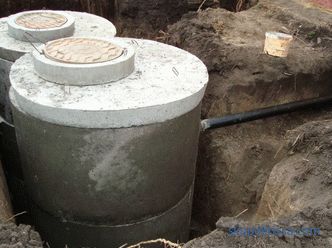
Volumes of septic tanks, dimensions of concrete rings, bottoms and floors
The total volume of the septic tank is defined as a three-day water requirement at the rate of 200 liters per person. The filter well is not included in this calculation.
Note! It is considered that the cycle of separation and treatment of wastewater is 72 hours.
For a single-chamber septic tank, the entire volume falls on the first chamber, for a two-chamber chamber, the containers are usually divided in a ratio of 2/3 and 1/3. Although many "simplify" the scheme and make both containers the same, but in this case the first one should be at least 2/3 of the calculated volume.
Knowing the volume of the septic tank, you can choose the optimal size from the standard series of wall rings of the COP according to GOST 8020-90.
Typically, sewage rings are selected from the KC15 or KS20 nomenclature.
KC7 is used as a well mouth (when it is needed).
KC10 has a volume of 0. 24 m 3 with a maximum ring height of 89 cm. The three elements of the first tank of a two-chamber septic tank will be enough only for drains from the life activity of one person. They can be used in the scheme of a two-chamber or three-chamber septic tank as rings for the second and third capacity, if the composition of the family is not more than three people.
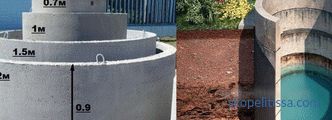
It can be interesting! In the article next Link read about plastic capacity for sewage.
KS13 can fit in volume, but it has only one height dimension - 89 cm. The “neighbor” in the KC15 series has two - 59 and 89 cm, which gives more possibilities in building a sewage system
There is also KC25, but for them only the floor plate is provided - there is no bottom.
With the bottoms the choice is simpler:
-
PN10 with a diameter of 150 cm;
-
PN15 (suitable for the KS13 ring) with a diameter of 200 cm;
-
ПН20 with a diameter of 250 cm
Note! You can "simplify" the design and installation, if for the lower element to choose a solid ring of the well with the bottom.
The floor slab is available for the entire range of wall rings except for KC7.
Choosing a place for a septic tank, installing a filter well
Choosing a place to place a septic tank is carried out taking into account regulatory requirements (5 m from a house, 30-50 meters from a water intake or reservoir). The second criterion is service. Although septic tanks do not require frequent pumping as cesspools, it is necessary to free containers from solid sediments - otherwise they will form a large layer of “mineral” deposits at the bottom, and this will reduce the performance of the cleaning system.
When biological tertiary treatment of wastewater in wells or fields, it must be borne in mind that they are suitable in soils with good filtering properties - sand and sandy loam.
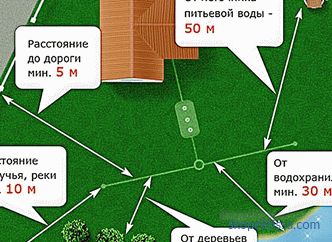
For weakly filtering soils, after the septic tank, filter trenches are arranged with collecting water from the storage tanks for irrigation water.
If, according to the geological features of the site, a scheme with trenches and filtration fields is chosen, then it must be borne in mind that only a lawn can be broken into their area or small shrubs with a shallow root system can be planted.
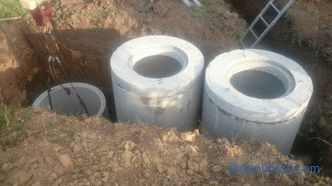
The filter well does not have a sealed bottom - instead, it is filled with a mixture of gravel (crushed stone) with sifting or large by sand. The height of the backfill is about 30 cm. It is no longer done due to difficulties during the subsequent replacement.
The rest of the filtration load of treated effluents is taken by backfilling around the “perforated” walls of the well. The recommended layer thickness is 30 cm. The perforation of the walls should start from the bottom and end at the level of the pipe entrance from the overflow of the last chamber of the septic tank. For the walls, either ordinary well rings are used, in the walls of which, prior to installation, holes of diameters 3-6 cm are made (with a total area of at least 10% of the total), or special perforated rings are installed for drainage wells.
Obviously about the choice of place for a septic tank and sewage for a private house of concrete rings, see the following video:
Features of the installation
The sewer rings are installed on the bottom plate, which serves as a slab foundation. The precast concrete structure must have a stable and reliable base. It also requires preparation of the bottom of the pit: leveling, tamping, backfilling of a layer of sand and rubble.
During installation, sealing of joints with cement mortar is required, followed by treatment of the entire surface with waterproofing compounds.
Tip! You can select rings with a quarter - profiled ends. They give a more reliable connection in terms of the accuracy of the joining, the structural strength, and the tightness of the seam.
The recommended height of the wells is no more than three rings. If done higher, the design will be "weaker."
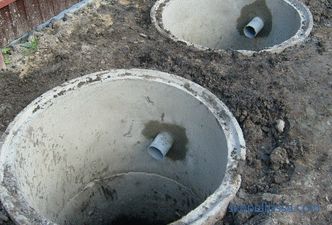
The inlet to the first well is mounted at least 30 cm from the lid. And the overflow holes are made with a slight decrease. This leads to a decrease in the "working" volume of the septic tank, which must be considered when choosing the size of the rings.
See the following video for an example of mounting a septic tank made of concrete rings:
It might be interesting! In the article next link read about the angle of the sewers at 1 meter in a private house.
Conclusion
Calculation, design and construction of any type of independent sewage system is a task for specialists. And if the use of factory septic tanks simplifies this task, then individual schemes using concrete rings require the involvement of professional builders who have experience in working with prefabricated reinforced concrete structures.



